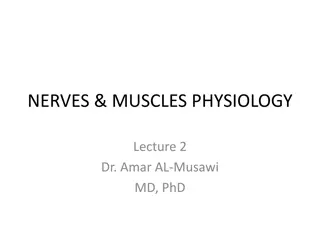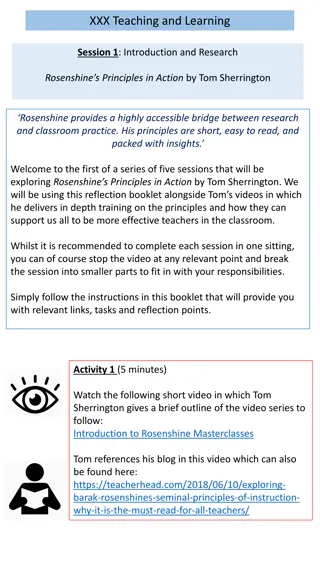
Effective Teaching Practices: Bridging Research and Classroom
Discover the impactful principles proposed by Rosenshine, supported by evidence-based research spanning four decades. Explore the 17 teaching principles of effective instruction, focusing on daily review, small-step instruction, questioning techniques, modeling, practice guidance, and more. Reflect on the importance of instructional support in enhancing student learning and the need to avoid cognitive overload. Enhance your understanding of key concepts and practices in education.
Download Presentation

Please find below an Image/Link to download the presentation.
The content on the website is provided AS IS for your information and personal use only. It may not be sold, licensed, or shared on other websites without obtaining consent from the author. If you encounter any issues during the download, it is possible that the publisher has removed the file from their server.
You are allowed to download the files provided on this website for personal or commercial use, subject to the condition that they are used lawfully. All files are the property of their respective owners.
The content on the website is provided AS IS for your information and personal use only. It may not be sold, licensed, or shared on other websites without obtaining consent from the author.
E N D
Presentation Transcript
MOT: Rosenshines Principles in Action Attempting to bridge the gap between research and classroom practice (We hope!!)
Evidence Based Research on Effective Teaching and Learning Study spanned 4 decades Consisted of Research into cognitive science Research into the classroom practice of Master Teachers (!) Research on cognitive supports to help students learn complex tasks
Breaking down into 10 principles and subsequently 4 strands 1. Daily Review (retrieval) 2. Present new material using small steps 3. Ask questions 4. Provide models 5. Guide student practice 6. Check for understanding 7. Obtain a high success rate 8. Provide scaffolds for difficult tasks 9. Independent practice 10.Weekly and monthly review
1. 2. 3. 4. 5. 6. 7. 8. 9. 10. Daily Review (retrieval) Present new material using small steps Ask questions Provide models Guide student practice Check for understanding Obtain a high success rate Provide scaffolds for difficult tasks Independent practice Weekly and monthly review Sequencing concepts and modelling 2.Present new material using small steps 4.Provide models 8.Provide scaffolds for difficult tasks Questioning 3.Ask Questions 6.Check for Student Understanding Reviewing material 1.Daily Review (retrieval) 10.Weekly and monthly review Stages of Practice 5.Guide student practice 7.Obtain a high success rate 9.Independent pracitce
Rosenshine makes an important statement based on the research, do you agree? The most effective teachers ensured that their students efficiently acquired, rehearsed and connected background knowledge by providing a good deal of instructional support
Not to cognitively overload pupils Recognise the limitations of the working memory How often do we mix the generic instruction with the curriculum content in practice?
Where have we seen these terms before? Now you have learnt about Roches moutonn es RAG your understanding of the key term in your books Definition: rock hills shaped by the passage of ice to give a smooth up-ice side and a rough, plucked and cliffed surface on the down-ice side. The upstream surface is often marked with striations. Now locate the Roches moutonn es example on your maps
1. Physical Representations 2. Conceptual Models 3. Explicit Narration/Thinking Aloud
Worked examples: A quick Think, Pair, Share for us . Model the general pattern Provides a strong basis from which to learn What worked examples would we provide in; - A maths lesson on solving problems with Multiplication and Division? - A DT lesson focusing on cooking a Healthy Meal? - A History lesson about an artefact brought in by the teacher - A French lesson on the past tense
PEEL: Point, Evidence, Explain, Link SQuID: Statement, quotation, Inference, Development PETAL: Point, Evidence, Technique, Analyse, Link We don t still ride bikes with stabilisers do we?
Scaffolds can be examples or problems to solve What fraction is shaded? Most problem solving subjects have a relatively small set of archetypal problems. If pupils can become familiar with them, cognitive load is greatly reduced. Multiple exposure increases capacity to problem-solve






















